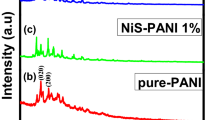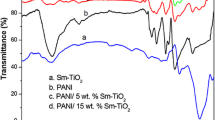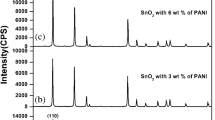Abstract
Polyaniline/zinc oxide nanocomposites (PANI/ZnO NCs) have been synthesized by chemical oxidative polymerization of aniline in a dispersion containing different weight content of ZnO nanoparticles (NPs) (1.5, 3, 5, and 8 wt% to aniline). ZnO NPs were prepared by combustion method. The structural, morphological, thermal properties of the synthesized PANI/ZnO NCs were evaluated using various analytical tools such as FTIR, TEM, SEM, TGA, and XRD. The variation of electrical conductivity and permittivity of the synthesized NCs with frequency was studied. The antibacterial activities of the NCs to Escherichia coli and Staphylococcus aureus were evaluated. FTIR data of the NCs proved the formation of H-bonding between ZnO and –NH of PANI. XRD pattern of ZnO showed hexagonal wurtzite crystalline structure of particle size 46.67 nm, while the addition of ZnO NPs to poorly crystalline PANI indicated nearly the same crystalline structure. TEM of ZnO NPs showed hexagonal and pseudospherical crystalline structure, while that of PANI/ZnO NCs revealed ZnO NPs were coated in PANI matrix. SEM images displayed uniformly dispersed ZnO NPs in PANI matrix with minute agglomerated particles. Medium antibacterial activity to E. coli was obtained for all NCs, while that containing 8% ZnO revealed high activity to Staphylococcus aureus. The variation of conductivity of the NCs with frequency at room temperature showed that ZnO plays an important role in conduction mechanism such that different phases were obtained. NC containing 5% ZnO possessed the highest conductivity. The permittivity of NCs decreased with the frequency and increased with increasing temperature. The dielectric loss decreased with the frequency indicating energy conservation.














Similar content being viewed by others
References
Raghavendra SC, Khasim S, Revanasiddappa M, Prasad MVN, Kulkarni AB (2003) Synthesis, characterization and low frequency a.c. conduction of polyaniline/fly ash composites. Bull Mater Sci 26:733–739
Umare SS, Shambharkar BH, Ningthoujam RS (2010) Synthesis and Characterization of polyaniline-Fe3O4 nanocomposite: electrical conductivity, magnetic, electrochemical studies. Synth Met 160:1815–1821
Choudhury A (2009) Polyaniline/Silver nanocomposites: dielectric properties and ethanol vapor sensitivity. Sens Actuators, B 138:318–325
Varga M, Prokes J, Bober P, Stejskal J (2012) Electrical conductivity of polyaniline-silver nanocomposites. In: WDS12–Proceedings of Contributed Papers, Part III, pp 52–57
Pavol K (2015) Polyaniline nanoparticles: Composite for gas sensors preparation and characterization. Ph.D. Thesis, Slovak University of Technology in Bratislava
Das TK, Prusty S (2012) Review on conducting polymers and their applications. Polym Plast Technol Eng 5:1487–1500
Roy AS, Anilkumar KR, Prasad MVN (2012) Studies of AC conductivity and dielectric relaxation behavior of CdO-doped nanometric polyaniline. J Appl Polym Sci 123:1928–1934
Reda SM, Al-Ghannam SM (2012) Synthesis and electrical properties of polyaniline Composite with silver nanoparticles. Adv Mater Phys Chem 2:75–81
Liang X, Sun M, Li L, Qiao R, Chen K, Xiao Q, Xu F (2012) Preparation and antibacterial activities of polyaniline/Cu0.05Zn0.95O nanocomposites. Dalton Trans 41:2804–2811
Bogdanovic U, Vodnik V, Mitric M, Dimitrijevic S, Skapin SD, Zunic V, Budimir M, Stoiljkovic M (2015) Nanomaterial with high antimicrobial efficiency-copper/polyaniline nanocomposite. ACS Appl Mater Interfaces 7:1955–1966
Mohsen RM, Aby- Selim MM, Ayana YM, Morsi SM, Ghoneim AM, El-Sawy S (2016) Nanotechnology and nanomaterials. In: Waqar A (ed) Nanomaterials and nanotechnology. One Central Press, UK, pp 145–179
Kaur A, Saini D, Kaur H (2016) Synthesis, characterization and applications of ZnO nanoparticles: mini review. Int J Eng Sci 18:59–78
Radzimska AK, Jesionowski T (2014) Zinc Oxide-from synthesis to application: a review. Mater 7:2833–2881
Kumar KM, Mandal BK, Naidu EA, Sinha M, Kumar KS, Reddy PS (2013) Synthesis and characterisation of flower shaped zinc oxide nanostructures and its antimicrobial activity. Spectrochim Acta, Part A 104:171–174
Shi LE, Xing L, Hou B, Ge H, Guo X, Tang Z (2010) Inorganic nano mental oxides used as anti-microorganism agents for pathogen control. In: Mendez-Vilas A (ed) Current research, technology and education topics in applied microbiology and microbial biotechnology, 2nd edn. Formatex Research Center, Badajoz, pp 361–368
Sivakumar K, Kumar VS, Shim JJ, Haldorai Y (2014) Photocatalytic and antimicrobial activities of poly(aniline-co-o-anisidine)/zinc oxide nanocomposite. Asian J Chem 26:600–606
Eskizeybek V, Gulce H, Gulce A, Avci A, Akgul E (2012) Preparation of polyaniline/ZnO nanocomposites by using arc-discharge synthesized ZnO nanoparticles and photocatalytic applications. J Fac Eng Arch Selcuk Univ 27:111–120
Sinha S, Bhadra S, Khastgir D (2009) Effect of Dopant type on the properties of polyaniline. J Appl Polym Sci 112:3135–3140
Patil SL, Pawar SG, Chougule MA, Raut BT, Godse PR, Sen S, Patil VB (2012) Structural, morphological, optical, and electrical properties of PANi-ZnO nanocomposites. Int J Polym Mater Polym Biomater 61:809–820
Ansari SP, Mohammad F (2012) Studies on nanocomposites of polyaniline and zinc oxide nanoparticles with supporting matrix of polycarbonate. Int Sch Res Notices 2012:1–7
Mostafaei A, Zolriasatein A (2012) Synthesis and characterization of conducting polyaniline nanocomposites containing ZnO nanorods. Prog Nat Sci Mater Inter 22:273–280
Alam M, Alandis NM, Ansari AA, Shaik MR (2013) Optical and electrical studies of polyaniline/ZnO nanocomposite. J Nanomater 2013:1–5
Ansari SP, Mohammed F (2010) Electrical studies on the composite of polyaniline with zinc oxide nanoparticles. IUP J Chem 3:7–18
Ahmed YM, Hassan SM (2014) Effect of ZnO particle size on A.C. electrical properties of prepared polyaniline ZnO composites. Int J Based Appl Sci 3:34–38
Kermani AS, Mirzaee M, Moghaddam MG (2016) Polyvinyl alcohol/Polyaniline/ZnO nanocomposite: synthesis, characterization and bactericidal property. Adv Biol Chem 6:1–11
Mostafaei A, Nasirpouri F (2013) Preparation and characterization of a novel conducting nanocomposite blended with epoxy coating for antifouling and antibacterial applications. J Coat Technol Res 10:679–694
Nasiiri H, Motlagh E, Valhdati JK, Zebarjad SM (2012) Role of fuel/oxidizer ratio on the synthesis conditions of Cu–Al2O3 nanocomposite prepared through solution combustion synthesis. Mater Res Bull 47:3676–3680
Bauer AW, Kirby WM, Sherris JC, Turck M (1966) Antibiotic susceptibility testing by a standardized single disk method. Am J Clin Pathol 45:493–496
Parra MR, Haque PZ (2014) Aqueous chemical route synthesis and the effect of calcination temperature on the structural and optical properties of ZnO nanoparticles. J Mater Res Technol 3:363–369
Hassan F, Miran MS, Simol HA, Susan MAB, Mollah MYA (2015) Synthesis of ZnO nanoparticles by a hybrid electrochemical-thermal method: influence of calcination temperature. Bangaladish J Sci Ind Res 50:21–28
Vermeulen AC (2001) An elastic constants database and XEC calculator for use in XRD residual stress analysis. Adv X-Ray Anal 44:128–133
Tian L, Lin B, Wu L, Li K, Liu H, Yan J, Liu X, Xi Z (2015) Neurotoxicity induced by zinc oxide nanoparticles: age-related differences and interaction. Sci Rep 5:16117–16127
Srinivasan N, Rangasami C, Kannan JC (2015) Synthesis structure and optical properties of zinc oxide nanoparticles. Int J Appl Eng Res 10:343–345
Kango S, Kalia S, Celli A, Njuguna J, Habibi Y, Kumar R (2013) Surface modification of inorganic nanoparticles for development of organic–inorganic nanocomposites-a review. Prog Polym Sci 38:1232–1261
Abd El-kader FH, Hakeem NA, Elashmawi IS, Ismail AM (2013) Structural, optical and thermal characterization of ZnO nanoparticles doped in PEO/PVA blend films. Aust J Basic Appl Sci 7:608–619
Jonscher AK (1977) The ‘universal’ dielectric response. Nature 267:673–679
Tcheliebou F, Boulouz M, Boyer A (1996) Electrical behaviour of thin ZrO2 films containing some ceramic oxides. Mater Sci Eng, B 38:90–95
Acknowledgements
The authors greatly appreciate the National Research Center for the financial support of this research article derived from Project No. 10050408. They thank Prof. Dr. Mohamed Hashem, vice president of National Research Center of research affairs and international relations, for his continuous support.
Author information
Authors and Affiliations
Corresponding author
Rights and permissions
About this article
Cite this article
Mohsen, R.M., Morsi, S.M.M., Selim, M.M. et al. Electrical, thermal, morphological, and antibacterial studies of synthesized polyaniline/zinc oxide nanocomposites. Polym. Bull. 76, 1–21 (2019). https://doi.org/10.1007/s00289-018-2348-4
Received:
Revised:
Accepted:
Published:
Issue Date:
DOI: https://doi.org/10.1007/s00289-018-2348-4




